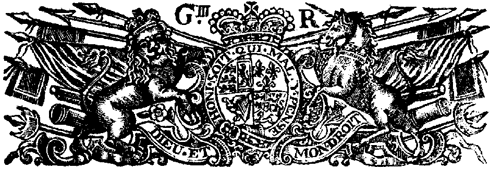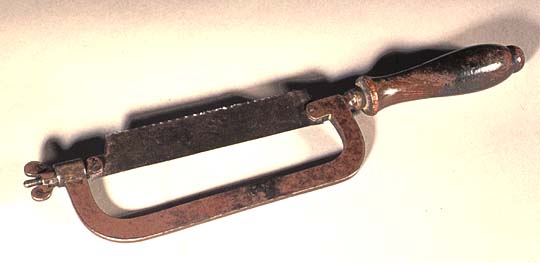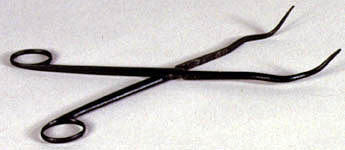

The First Foot Guards
We are a Revolutionary War
reenactment group based in Boston MA,
accurately portraying the royal household regiment that is now known as
The Grenadier Guards
The Chirurgeon*
The offices of Surgeon
and Surgeon's Mate are impressively fulfilled by
Dr Thomas Keenan
and Mr William Sherburne
*The word Chirurgeon is as alternate spelling of Surgeon
was is used interchangeably
Surgeon's
Mate on the left, Surgeon on the right.
At Lexington Green, 2002
Notice that Dr Keenan wears an officer's waist sash, gorget and sword
because he is also a Lieutenant of Light Infantry
Diseases
Click
An Overview
of 18th Century Medicine
Click
We are lucky to have the services of Dr Keenan, who is in real life a cardiologist. On the other hand, Mr Sherburne, though Harvard educated, has no medical experience whatever! He is, however, ever ready to serve an ailing Private Soldier with a (second-hand) bandage, a salve of SPF 40, a tot of medicinal rum, or a liberal slice of wry humor.
Both gentlemen would be far overeducated for a real life Surgeon and Mate of
the period. No medical qualification, or even education, was necessary. It was
a useful skill, but not mandatory. This was the situation in civilian life,
where physicians were formally trained, and surgeons learned their trade as
they went along, often by apprenticeship. In civilian life, pharmacists (as
well as untrained merchants) prescribed treatments and remedies. However,
there was no guarantee that a college-trained surgeon would give you better
care. There were many different theories of disease and health at this period,
all of which seem curious and ill-informed to the modern observer. There was
no concept of antisepsis or of the germ theory, so where disease came from was
a profound mystery to medicine.
As in civilian life, actual surgical procedures were limited to those that threatened the life of the patient. Surgeons were a last resort.
An army surgeon would perform:
Amputations.
A musket ball would often totally shatter the bone and destroy muscle, arteries
and nerves. A skillful surgeon could perform an amputation in less than three
minutes. The stump of the limb then had to be sealed by sewing, cauterization
or sealing with pitch.

Amputation saw
Removal of the
musket ball (or artillery shards),
either from a limb or body cavity. The surgeon had several
instruments for this.
Note that the term 'shrapnel' refers to missiles of case shot, and not (as in common parlance from shell fragments). 'Shrapnel' was not invented until the early years of the 1800s.

Curved forceps for the removal of bullets
Trepanning.
Removal of a circle of the cranium to 'release pressure on the brain'.
and
Tooth extractions.
In camp our medical staff will readily show off their collections of medicaments and grisly instruments. They will regale you with vivid stories of their more interesting probings, extractions and amputations, and will be most happy to demonstrate their skills with saws and trepans, should any unfortunate soldier fall under their eager hands.

Lancet and leather case
"No
medical corps in the modern sense of the word, existed. Ever since the time
of King Charles II, there had been a Physician General and a Surgeon General,
and since 1758 Inspectors of Hospitals, but little is known regarding their
functions. According to Regulations, a Surgeon and Mate were attached to each
Regiment of Foot. They were, however, essentially regimental officers. Although
holding their commission of the King, they were really appointed by the Colonel,
whose servants they originally had been.
In many instances their professional knowledge must have been slight. The surgeons
were not required to hold a medical diploma or degree, nor the mates to pass
a medical examination. Army doctors labored under other disadvantages besides
ignorance an inexpert assistants. They were poorly paid."
EE
Curtis, The Organization of the British Army in the American Revolution
1926, Yale University, New Haven CT.
Pay scale
Surgeon
Guards regiments: 4/-
Line regiments: 4/-
Surgeon's Mate
Guards regiments: 3/-
Line regiments: 3/6
L-R
Mr Sherburne, Chirurgeon's Mate
Serjeant-Major Ozelius
Dr Keenan, Chirurgeon
On the aftermath of the Battle of Guilford Courthouse
"I
never did and I hope that I never shall experience two such days and nights
as those immediately after the battle. We remained on the very ground on which
it had been fought, covered with dead, with dying and with hundreds of wounded,
rebels as well as our own. A violent and constant rain that lasted above forty
hours made it equally impracticable to remove or administer the smallest comfort
to our wounded."
General Charles O'Hara
An Overview of 18th Century Medicine
With the advent of the age of intellectual enlightenment, new theories developed to explain disease and its treatments. The older theory of excess or deficiency of the four bodily humors was discarded. In Edinburgh, now the Western intellectual medical capital, Dr John Brown developed the notion that good health was dependent upon the amount of nervous stimulation upon body tissues. Excessive stimulation led to spasm of muscle, blood vessels or organ and this was the cause of the disease. Too little nerve stimulation led to weakness. A popular variant of this was Dr. William Cullen's theory that nerve irritability led to alteration of body fluids, which in turn, was the cause of all disease.
Physical signs became the disease rather than the signs of a specific illness. Fever was, therefore, the illness caused by excessive nerve stimulation and the goal of the treatment was reduction of that fever. Excessive stimulation could be reduced by blood letting which caused the patient to become lethargic due to profound anemia due to blood loss. Purging was also a popular mode of reducing stimulation through the production of dehydration. Alcohol might be used, functioning as a depressant, or gradual starvation with weak broths in place of proper nutritional support.
If this did not work or spontaneous recovery did not take place, then a new stratagem was used. A competitive stimulation would be used to induce vomiting or diarrhea with unpleasant substances. The skin could also be irritated with unpleasant substances. There was no following of the patient's vital signs.
The use of medications was limited. Anodynes were a class of medicines used to reduce nerve inflammation, but were not given in sufficient quantities to relieve pain. Pain was always with the individual and relief of pain was not of the same values as today. The 'bark' which contained quinine was effective against malaria, but was given to anyone with fever or jaundice. Similarly, as stated above, compounds still used today were known to induce diarrhea, vomiting and cause counter-irritation.
Surgery was limited in its applications. Simple wounds would be closed by approximation with adhesives, and suturing was done. Usually sutures were removed in three days, however. Thoracic (chest) and abdominal injuries were simply probed. Recovery was related to a major blood vessel or organ not being damaged by the trauma. The theory that gunpowder was the cause of inflammation and infection had just been discarded. Surgery was limited to amputations and trephination. Amputation of a leg was usually carried out just below the knee and the decision to amputate was made quickly. Amputation of the arm immediately was beginning to be questioned. Questions of healing were being raised about salvage of the limb in a city hospital versus the country. Reduction of compound fractures was being attempted. The hallmark of surgery was rapidity of action. To have completed an amputation in three or four minutes was the norm. Trephination was also carried out; that is, removal of a circular piece of bone from the skull and drainage of blood (subdural hemorrhage) or removal of bone or foreign matter (reduction of a depressed skull fracture or infection). The procedure had been performed before ancient Egypt. The survival rate was about 75%. Infection was thought to be part of the healing process. About the fourth day after injury 'laudable pus' developed, probably a staphylococcal infection, and this was part of the concept of healing. Also inflammation as part of wound healing had not yet been considered.
Infectious diseases frequently occurred in epidemics. There appeared to be an annual cycle with dysenteric illnesses occurring in the late spring and summer, and respiratory illnesses occurring in the cooler weather. Generally, mild winters were associated with more severe illness, such as the smallpox epidemic occurring in Boston in the winter of 1774-1775. Smallpox was one of the few infectious diseases which could be prevented. Aside from fumigation, primitive vaccination had been carried out by Dr. Zabdiel Boylston in the 1720s, and Dr. Joseph Warren has encourage vaccination in 1774. Inoculation through a skin scratch was accomplished using material from a freshly drained pustule from an infected individual. George Washington insisted that his wife undergo this procedure before coming to Cambridge in 1775.
Typhus, a disease transmitted by lice, was treated by aerating and ventilation in the hospital and barracks. This was the idea of Dr. John Pringle who was the Surgeon General during the 1750s. Ridding the hospital of old blankets and linen and the concept of keeping the water supply pure, were developing as procedures to reduce the spread of typhus.
Diseases were grouped by their symptoms rather than their causes. Such diseases as Diphtheria and Scarlet Fever were considered one. There was also great medical debate at the time whether Syphilis and Gonorrhea were the same illness. As above, these illnesses were thought to be the results of over-stimulation and were treated as above. If you had been fortunate enough to be given Quinine for Malaria, you stood a god chance of improvement. Some diseases simply ran their course and the patient was subjected to a much higher rate of secondary infection, complication and death. There were also diseases described, which we, in the 20th century, are unable to identify, particularly the high incidence of leg sores which are no longer seen.
All remained at this level for another hundred years until the development of the germ theory and the notion of washing one's hands.
______________________________________
It was not until 30 March 1842 that ether was first used as an anaesthetic during surgery, by US doctor Crawford Long. Even then, there were professionals who scoffed at this:
"The
abolishment of pain in surgery is a chimera. It is absurd to go on seeking it.
'Knife' and 'pain' are two words in surgery that must live forever in the consciousness
of the patient."
Dr Alfred Velpeau of the Paris Faculty of Medicine was an old-school
physician who was unimpressed.
The
lack of sanitation in the cities
Military Medicine in the Revolutionary War
although this is a US Army treatise,
it is still pertinent, especially the first chapter "The State of the Art"
Offsite
link
National Park Service
on Medicine
Contains interesting pictures
of artifacts
Offsite
link
Recommended reading:
Dr Keith Wilbur's entertaining and profusely illustrated books
on RevWar medicine.
Reasonably priced. Globe Pequot Press
Offsite
link